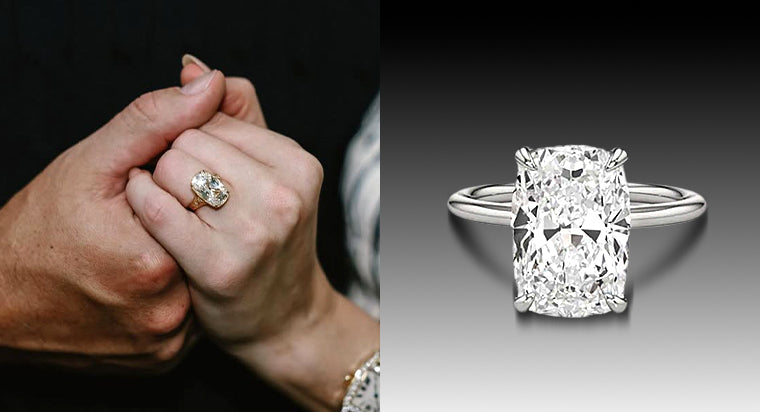Lab grown vs. Natural Diamond Engagement Rings: Which One Should You Really Choose?

You’re faced with plenty of choices when you start shopping for engagement rings. Getting or gifting a diamond engagement ring is a significant purchase, and you want the ring to be perfect. One decision that you might not think about is whether you want natural or lab grown diamonds for your engagement ring. We’ll cover lab-grown and natural diamonds so you can determine which you should choose.
Table of Content
Understanding Lab-Grown Diamonds
The process of creating a lab grown diamond is similar to the process to create natural diamonds – the only difference is one occurs within the earth’s crust and the other occurs in a laboratory. To create a lab grown diamond, the manufacturing process replicates conditions that create a natural diamond creation–extreme temperatures and pressures that turn carbon into a diamond.
Manufacturers have two ways to create lab diamonds – High Pressure High Temperature (HPHT), and Chemical Deposition (CVD):
- HPHT: A diamond “seed” is added to carbon. A diamond seed is a small natural diamond fragment that can undergo both extreme temperature and pressure conditions. The HPHT diamond growth process subjects diamond seed and carbon to extreme temperatures (in excess of 1,300-1,600 degrees celsius) and pressures (one million pounds per square inch) to replicate the extreme heat and pressure conditions deep within the earth where natural diamonds form. The carbon forms around the diamond seed and is then cooled.
- CVD: The chemical vapor deposition system begins with a diamond “seed.” Selecting the strongest and highest grade (in color and clarity) natural diamond bit is important. During the CVD process, the vacuum chamber in which the diamond seed is placed fills with gasses that are heavy in carbon and is then heated to well over 1,000 degrees. The intense heat then turns the gasses into “plasma.” The plasma is what helps “build” the layers of the diamonds.
Each lab diamond takes about a month to produce, then cut and polished like a natural diamond.
Natural Diamonds
Natural diamonds form deep within the Earth’s crust as a result of extreme temperatures and pressures that turn carbon into a diamond. The process takes millions of years, and natural diamonds are rare – especially larger diamonds. Unlike most natural diamonds, you can pinpoint the origin of lab grown diamonds.
Cost Comparison
Lab grown diamonds are more affordable in comparison to natural diamonds. You can expect to pay 15% to 30% less on a lab diamond than you would on a mined diamond. This price difference is because mined diamonds go through a longer supply chain and require more costly resources.
Environmental Impact
Lab-created diamonds are more environmentally friendly than natural diamonds. While companies use resources to create lab-grown diamonds, they have a smaller carbon footprint compared to mined diamonds, which makes them more environmentally friendly. Natural diamonds use more natural resources to mine them from the earth.
Ethical Considerations
Lab-created diamonds are an ethical choice in diamonds. They’re conflict-free, and you know exactly where they were made. Conflict diamonds (also called “blood” diamonds) refer to gemstones that are mined in war zones to perpetuate war or to fund warlords and insurgents. Many natural diamond origins are unknown. Choosing a lab-grown diamond means you aren’t supporting conflict diamonds.
Certification and Grading
Lab diamonds that are certified come accompanied with detailed documentation regarding their quality and their origin. A certified lab diamond confirms that it is lab-grown and the quality of the diamond (color, clarity, and often cut) meets a certain standard according to a qualified, experienced gemologist. Well-known organizations that grade diamonds include GIA (Gemological Institute of America) and the International Gemological Institute (IGI). GIA has graded laboratory-grown diamonds since 2007. Certification also ensures that you can pinpoint the origin of the diamond–they’re traceable and conflict-free.
Durability and Longevity
Both lab-grown and natural diamonds are durable and withstand years of wear. Diamonds remain the hardest material on earth — a 10 on the Mohs hardness scale, and lab-grown diamonds are as difficult to chip as natural diamonds.
Lab Grown vs Natural Diamond Engagement Ring–Which should you choose?
The ultimate decision comes down to several factors, including your personal values, preferences, and budget. You’ll have to weigh the pros and cons of lab and natural diamonds and decide what works best for you. Consider your budget, opinions of conflict-free diamonds, and environmental impacts of diamond mining. You’ll need to determine what’s important to you for your engagement ring in order to determine what type of diamond works best for you.
FAQs
Is a lab diamond better than a real diamond?
Lab diamonds and natural diamonds each have their advantages and disadvantages. You’ll have to determine which stone is best for your needs and personal preferences.
Are lab diamonds the same as real diamonds?
Yes, lab diamonds are real diamonds that share the same chemical composition, optical properties, and physical features as natural diamonds. Natural diamonds are mined in the earth, and lab diamonds are created in a lab.
What are the disadvantages of lab grown diamonds?
Lab-grown diamonds are more affordable, but their value likely will not hold up over time. They will also never have the same rarity and meaning as a natural stone that was formed over billions of years deep in the earth.
Are lab diamonds and synthetic diamonds the same?
No, lab diamonds and simulated diamonds are not the same. Simulated diamonds are stones that only look like diamonds, like cubic zirconia, white sapphire, moissanite, zircon, rutile, spinel, and synthetic garnet. On the other hand, lab diamonds have the same properties as natural diamonds.









